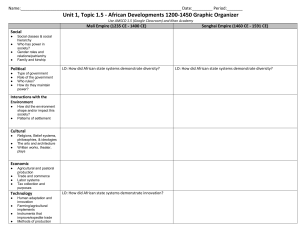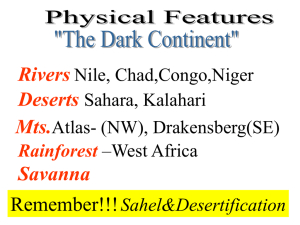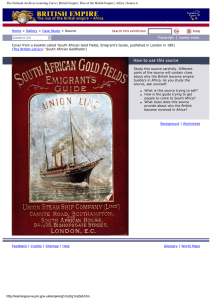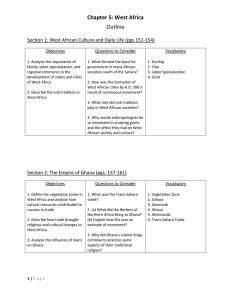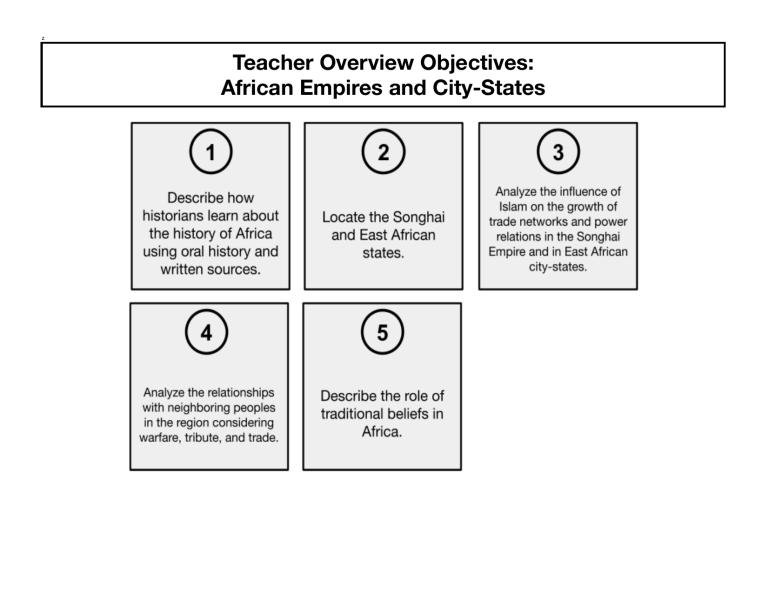
z Teacher Overview Objectives: African Empires and City-States How do we know what we know about early African kingdoms and city-states? Objective: Describe how historians learn about the history of Africa using oral history and written sources. Directions: Read the documents and respond to the questions. Document 1: Why did some historians believe that Africa had no Until the late colonial period, it was widely believed among Western history? historians that Africa, south of the Sahara, had no “civilization” and thus no history. Others insisted that even if there were events of a historical nature, such a history was unknown and unknowable, since African societies, for the most part, were non-literate and as such left no records that historians could study. [...] What three sources have contemporary scholars and Using an array of sources, these scholars were successful in showing that Africa not only had a history but that its history and the writing of it date historians used to learn about the history of Africa? back to ancient Antiquity. Ancient and classical writers wrote about Africa, even though their writings were unsystematic. They were followed by Islamic and Arabic writers, who left first- or second-hand accounts of African states and societies that have continued to prove valuable for scholars of African history. The next phase of African historiography was dominated by European traders, travelers, as well as missionaries and other adventurers [...] Source:http://www.oxfordbibliographies.com/view/document/obo-9780199846733/obo-97801998467330011.xml Document 2a Document 2a: The image to your left depicts griots. From this image, what can you infer about what role griots may have played in West African society? Source: Griots de Sambala, roi de Médine (illustration de Côte occidentale d'Afrique du Colonel Frey) Fig.81 p.128 - [Cote : Réserve A 200 386] / http://commons.wikimedia.org/wiki/File:GriotsSambala.jpg Document 2b Context: Early and medieval African societies preserved their histories through written and oral literature. In West Africa, griots, a highly honored professional storyteller recited ancient stories that would be passed on from generation to generation. The griot is often viewed as a leader in their society because they preserve the history. One of the more well-known griot stories is the Epic of Sundiata. It tells the story of the hero Sundiata Keita (died 1255), the founder of the Mali Empire. Document 2b: According to this excerpt, what is a griot? The West African epic of [Sundiata], the Mande king, has been transmitted orally by professional bards called griots (or jali in the Mande languages) What can we learn about Sundiata from the Epic of since at least the fourteenth century. [Sundiata] Keita was a historical king of Sundiata? the Mandean Empire during the thirteenth century, but there are few written accounts of his life. Nearly all of what is known about him comes from variations of this famous oral tale, which over the centuries spread from Mali and Guinea to regions of Senegal, Gambia, and Burkina Faso. The tale tells of a boy born to King Makhang and one of his wives, a deformed woman named Sogolon who is believed to have magical powers. [Sundiata] grows up bent and crippled like his mother, but he also apparently possesses her gift, for one day, angered by an insult to her, he uproots a What can we learn about West African history from the baobab tree and grows instantly straight and tall (in some versions of the Epic of Sundiata? story he grows straight simply by leaning against his mother's shoulder). Even as a boy he possesses many virtues, including humility, strength, courage, and above all filial piety.[Sundiata] goes on to become a great king, surrounding himself with strong warriors and wise counsel. He defeats the Susa king Sumanguru through the use of wit and magic [...] [Sundiata] unites the territories surrounding his kingdom into the strongest and richest state of Africa. What can we learn about the importance to history and The traditional role of the griots is an essential element in the tale of storytelling in West African culture from the Epic of [Sundiata]. It was the duty of these storytellers to be the official memory of Sundiata? their kings, and thus of their people, connecting members of the community to one another as well as to their collective past. Griots were (and still are) trained in their art from childhood, acquiring the stories and legends of their ancestors, studying the tradition of oral poetry, and learning to accompany their stories on musical instruments, such as a twenty-one-string harp, a xylophone, or a small lute. Source: http://bcs.bedfordstmartins.com/worldlit/content.asp?b=3&c=litlinks&r=Africa&i=sunjata Where were the Songhai Empire and East African city-states located? Objective: Identify the location of the Songhai Empire and East African city-states Kingdoms and City-States in West Africa and East Africa Kingdoms of West Africa Wonder What about the information in this map do you wonder about? Write any question you have about the information in this map. Notice What do you notice about this map? Make factual statements based on the data presented. Think What do you think about the information in this map? Make inferences about the history it presents. 800-1050 Ghana 1050-1235 1235-1464 1464-1591 Kingdom of Mali Songhai Empire How did Islam influence the growth of trade networks and power relations in the Songhai Empire and in East African city-states? How did these empires and states consolidate power? Objective: Analyze the influence of Islam on the growth of trade networks and power relations in the Songhai Empire and in East African city-states. Describe the achievements of the Songhai Empire in consolidating their power? Directions: Read the documents and respond to the questions. Document 1 Under which empire did Islam spread The Mali Empire, which originated in the eighth century, gradually became the most powerful through West Africa? kingdom in the Sahel (the area south of the Sahara Desert), and the leader of the trans-Saharan gold and slave trade. Islam was first introduced to the Sahel region in the eleventh century and quickly spread throughout the region. Though traditional African religious remained popular among the populace, many of the leaders of the Mali Empire and subsequent states followed and supported Islam [...]. The cities of Timbuktu and Djenné were the economic centers of the Mali Empire and attracted traders, scholars, and artisans from across the Islamic world. Explain how the Songhai empire became the strongest empire in In the fifteenth century, unchecked growth and political infighting prevented the Mali from African history? addressing the spread of secession among their vassal states. The Tuareg, a Berber-speaking group, began encroaching on Malian territory, culminating in the capture of Timbuktu in 1430. The Mali were driven from their colonial territories and retreated to the upper Niger River, while the Sahel fractured into hundreds of warring states. Sonni ʿAli (d. 1492), who became Songhai emperor in 1464, led the military [...] With the city secured, the Songhai began a program of military expansion and eventually controlled the Niger Delta and the gold trade [...] By the 1480s, the Tuareg and Mossi had been [...] integrated into the Songhai state. What policy did the Songhai empire Sonni ʿAli instituted an administrative structure based on regional military leadership. The adopt to govern their diverse empire administration angered the Islamic community by granting equal status to native tribal religions of mostly non-Muslims? How did this policy allow the Songhai empire to and reducing the power and influence of Islamic sects [...] maintain and consolidate power? Sonni ʿAli died in 1492 after leading a military expedition [...] His son and successor was unable to consolidate support among the Islamic community and was overthrown in 1493 by Mohammed I Askia (d. 1538). The Songhai was the largest empire in African history, dominating thousands of tribes and controlling a region comparable in size to the United States. The central regions, including the major cities of Gao, Timbuktu, and Djenné, were predominantly Muslim. Timbuktu was one of the world’s foremost centers of Islamic scholarship and attracted students and religious adherents from across Africa and parts of Europe. More than 90 percent of Songhai subjects were non-Muslims, however, and the government adopted a policy of religious freedom, though Islam remained the dominant religion in the government. Source: "Songhai Empire." Gale Encyclopedia of World History: Governments. Vol. 1. Detroit: Gale, 2008. World History in Context. Web. 6 Apr. 2015.(http://tinyurl.com/songhaitext) Document 2 Based on this image, identify 3 achievements of the Songhai empire. Based on this image, what caused the decline of the Songhai Empire? How did African city-states and kingdoms interact with neighboring people? Objective: Analyze the relationships with neighboring peoples in the region considering warfare, tribute, and trade. Directions: Read the documents and respond to the questions. Document 1 The Songhai had settled on both banks of the middle Niger River. They established a state in the 15th century, which unified a large part of the western Sudan and developed into a brilliant civilisation [...] The capital was at Gao, a city surrounded by a wall. It was a great cosmopolitan marketplace where kola nuts, gold, ivory, slaves, spices, palm oil and precious woods were traded in exchange for salt, cloth, arms, horses and copper. [...] The slave trade was also important for the economic development of West Africa. For a very long time, West African kingdoms had relied on slaves to carry out heavy work. The Songhai kingdom under the rule of Askia Mohammed used slaves as soldiers. Slaves were trusted not to overthrow their rulers. Slaves were also given important positions as royal advisers [...] Another group of slaves was known as palace slaves or the Arbi. The Arbi slaves served mainly as craftspersons, potters, woodworkers, and musician. Slaves also worked on village farms to help produce enough food to supply the growing population in towns. Source: http://www.sahistory.org.za/topic/songhai-african-empire-15-16th-century Based on this excerpt, in addition to objects like food, oils, clothing, metals or animals, what else was traded in West Africa during the reign of the Songhai empire? Kingdoms and Trading States in East Africa Wonder What about the information in this map do you wonder about? Write any question you have about the information in this map. Notice What do you notice about this map? Make factual statements based on the data presented. Think What do you think about the information in this map? Make inferences about the history it presents. Document 2 Based on this table, what can you infer about trade in East Africa? Source: G.S.P. Freeman-Grenville, “East African Coin Finds and Their Historical Significance,” Journal of African History (adapted) from the NYS Global History and Geography Regents Examination, January 2010. Document 3 Islam in Africa: Crash Course World History Watch 6:53 https://www.youtube.com/watch?v=jvnU0v6hcUo 6:56 How were the East African Swahili city-states different from an empire? 7:08 These city-states formed a network of ________________ ports. 7:11 The East African Swahili city-states were autonomous and did not have to report to a central power. However, they were three things that linked the city-states that made them a common culture: 1) 2) 3) 7:51 Why did historians believe that the Swahili city-states were founded by Arabs or Persians? 8:10 Trade had been going on on the Swahili coast since the 1st century CE. Why did trading rapidly increase in the 8th century CE? 8:15 Arabs were looking to trade goods on the ________________________ trade complex otherwise known as the “Silk Road of the Sea” 8:20 Other than goods, what did Arab traders bring with them to the Swahili Coast. What effect did this have on religious and cultural life in the city-states? 8:43 What was exported from the Swahili city-states? What was imported to the Swahili city-states? 9:30 Why does John Green think it is important to study Africa using multiple sources? How did the growth of Islam in Africa affect the practice of traditional religions in Africa? Objective: Describe the role of traditional beliefs in Africa. Directions: Read the documents and respond to the questions. Document 1 Context: Before Islam and Christianity was introduced to West Africa, most Africans had a variety of complex traditional beliefs. Some Africans were polytheistic while others believed in animism. Animism was the belief that spirits and forces reside in animals, objects, and dreams. Others believed that the forces of nature like rains or wind had divine spirits and attempted to influence these rituals and ceremonies. Additionally, some African people believed that there was one supreme and unseen creator god with lesser gods beneath the creator god. Again, the beliefs were varied and complex. Many of these beliefs were challenged when Islam was introduced by West African kings in the 11th century. If you were living in West Africa during the 11th century, would you have abandoned your traditional religious beliefs for Islam? Why or why not? Islam in Africa: Crash Course World History Watch 3:40 - 5:00 https://www.youtube.com/watch?v=jvnU0v6hcUo 3:40 North Africa traded __________________ to West Africa in exchange for _____________________ . 4:00 What introduced Islam to West Africa? 4:10 Why did many West African kings convert to Islam? 4:30 Many people still practiced traditional beliefs in Africa. How did African kings rule over largely non-Muslim people? If you were a West African Islamic leader in the 11th century, how might your convince your people to convert to Islam?
